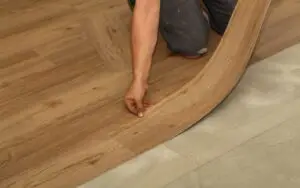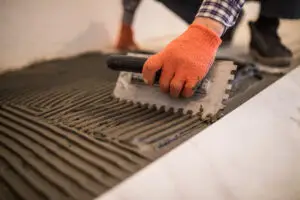Why You Should Hire a Professional to Install Hardwood Flooring
The Challenges of DIY Hardwood Flooring Installation
- Lack of specialized tools: Installing hardwood flooring requires professional-grade tools like pneumatic nailers and high-precision saws, which most DIYers don’t own.
- Difficulty ensuring proper alignment: Misaligned boards create gaps, creaks, and an uneven floor, problems that often go unnoticed until the installation is finished.
- Managing moisture and expansion: Hardwood expands and contracts with temperature and humidity changes. Improper installation can lead to warping and buckling.
Benefits of Hiring Skilled Flooring Installers
- Experience and expertise: Professional installers know how to handle various hardwood types and subfloor conditions, ensuring long-lasting results.
- Reduced installation time: Experts work efficiently, completing installations quickly without sacrificing quality.
- Warranty and peace of mind: Most professional flooring companies offer warranties, protecting your investment and guaranteeing proper installation.
Professional Equipment and Techniques for Flawless Results
- Precision cutting tools: Professionals use industrial-grade saws and tools to make clean, precise cuts that fit snugly against walls and corners.
- Proper fastening methods: Using the right nails, adhesives, and fasteners is critical for durability, and professionals ensure each plank is secured properly.
- Expert finishing: From sanding to staining, professionals ensure your hardwood floor looks smooth and polished.
The Professional Hardwood Flooring Installation Process
Pre-Installation Consultation and Assessment
- Room measurement and layout planning: A professional will take exact measurements of your space and consider any room complexities, like odd angles or existing furniture.
- Wood type and style selection: Professionals help you choose the best hardwood species, thickness, and finish to match your home’s style and traffic levels.
Preparing the Subfloor for Hardwood Installation
- Checking subfloor conditions: A proper subfloor is essential for successful hardwood installation. Professionals check for levelness, moisture content, and stability.
- Addressing imperfections: They correct unevenness or weaknesses by sanding, adding underlayment, or repairing damaged sections to create a perfect base.
Acclimating the Hardwood to Your Home Environment
- Time for wood to adjust: Hardwood flooring must be acclimated to your home’s humidity and temperature. Professionals ensure the wood stays in the home for the appropriate amount of time before installation.
Precision Installation of Hardwood Planks
- Strategic plank layout: Professionals map out the installation plan, ensuring that boards are aligned and balanced across the room.
- Expert cutting and fitting: They custom-cut boards to fit perfectly around edges, doorways, and other obstacles.
Finishing Touches: Staining, Sanding, and Sealing
- Sanding and smoothing: Once installed, professionals sand the floor to eliminate any height variations between planks.
- Applying the perfect stain: They can apply custom stains to achieve the desired finish, ensuring even color across the entire floor.
- Sealing for protection: Professionals apply sealants to protect your hardwood from scratches, spills, and wear.
Common Mistakes in DIY Hardwood Floor Installation
Inadequate Subfloor Preparation
- Uneven subfloors: DIYers often skip this critical step, leading to squeaky floors and premature damage.
- Overlooking moisture levels: Failure to account for moisture can result in warped or buckled floors.
Incorrect Plank Alignment and Gapping
- Visible gaps between planks: Misaligned boards lead to gaps, which are unsightly and can allow moisture to seep in, damaging the wood.
- Uneven rows: DIY installations often suffer from boards that don’t run straight, compromising the look and integrity of the floor.
Problems with Expansion and Contraction
- Not allowing for expansion gaps: Hardwood flooring expands and contracts with temperature changes. If not enough space is left between the planks and walls, the floor can buckle.
How Professional Installers Avoid Common Pitfalls
Proper Subfloor Evaluation and Preparation
- Moisture testing: Professionals use moisture meters to ensure the subfloor is dry and suitable for hardwood installation.
- Leveling and reinforcing: If the subfloor isn’t perfectly flat, they take the necessary steps to fix it, ensuring the hardwood will lay correctly.
Ensuring Perfect Alignment and Seamless Transitions
- Laser-guided alignment: Pros use laser tools to ensure each plank is placed in perfect alignment, preventing gaps and uneven edges.
- Smooth transitions: Where the hardwood meets another flooring material (like tile or carpet), professionals create smooth transitions to prevent tripping hazards.
Using Industry-standard Tools for Professional Results
- Precision tools: Professionals use high-quality tools that allow for precise cuts and secure fastening, ensuring the hardwood remains stable and durable over time.
Different Types of Hardwood Flooring to Consider
Solid Hardwood vs Engineered Hardwood
- Solid Hardwood: Made from a single piece of wood, it can be sanded and refinished multiple times. It’s durable but sensitive to moisture.
- Engineered Hardwood: Composed of multiple layers of wood and plywood, this option is more resistant to moisture and is ideal for areas with fluctuating humidity.
Popular Wood Species for Hardwood Floors
- Oak: Known for its durability and classic appearance, oak is one of the most popular choices for hardwood flooring.
- Maple: Maple offers a smooth, modern look with great resistance to wear and tear.
- Hickory: A harder option, hickory is great for high-traffic areas and adds a rustic feel to any room.
Pre-finished vs Unfinished Hardwood
- Pre-finished: Pre-finished hardwood comes ready to install with a factory-applied finish, reducing installation time.
- Unfinished: With unfinished hardwood, you can choose custom stains and finishes, but the installation process takes longer due to on-site sanding and sealing.
Factors That Impact Hardwood Flooring Installation Costs
Type and Quality of Hardwood Materials
- Premium hardwood species like walnut or cherry will increase costs, while more common options like oak are more affordable.
Room Size and Layout Complexities
- Larger rooms require more material and labor, and irregular room shapes or tricky areas (like stairs) can increase installation costs.
Additional Services like Sanding and Sealing
- Services such as sanding, staining, and sealing the floors may add to the overall cost, depending on the desired finish and level of customization.
The Long-term Benefits of Professional Hardwood Floor Installation
Enhanced Durability and Longevity
- Professionally installed hardwood floors are built to last, often for decades. Experts ensure that the flooring is securely fastened and well-finished, reducing wear and tear over time.
Boosting Home Value with High-quality Hardwood Floors
- Homes with professionally installed hardwood floors typically have higher resale values, making them a wise long-term investment.
Ease of Maintenance and Refinishing Over Time
- Hardwood floors installed by professionals are easier to maintain and can be refinished multiple times, extending their lifespan and keeping them looking new.
Compare DIY vs Professional Hardwood Flooring Installation
DIY Drawbacks
- Limited Tools and Expertise: DIY installers may lack the precision tools required for a flawless installation, resulting in uneven floors or improperly placed boards.
- Risk of Damage and Future Repairs: Mistakes made during installation, like improper subfloor preparation or failure to allow for wood expansion, can result in costly future repairs.
Benefits of Professional Installation
- Guaranteed Quality and Durability: Professional installers ensure that every step of the process is done correctly, from subfloor preparation to the final finishing touches.
- Warranties and Support Services: Many professionals offer warranties on both the labor and the materials, providing peace of mind and long-term protection for your investment.





